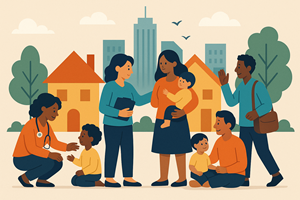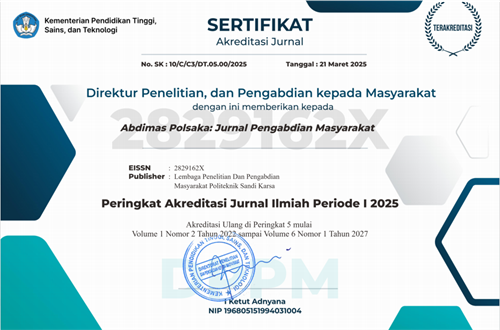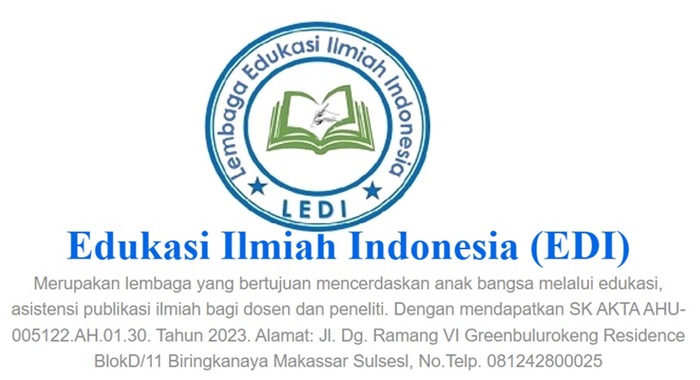OPTIMALCARE: Community-based homecare policy innovation in accelerating stunting reduction in Makassar City
DOI:
https://doi.org/10.35816/abdimaspolsaka.v4i2.107Keywords:
community-based homecare, nutrition monitoring, public health innovation, stunting reductionAbstract
Stunting remains a significant public health challenge in Makassar City, with prevalence rates exceeding national targets and World Health Organization thresholds. Contributing factors include socioeconomic disparities, limited access to healthcare, suboptimal parenting practices, and inadequate nutritional intake. The OPTIMALCARE program introduces a community-based homecare policy innovation to accelerate stunting reduction through integrated health services, family-centered nutrition education, routine growth monitoring, and a mobile nutrition monitoring application. This program engages health workers, Posyandu cadres, and community leaders to deliver proactive home visits, promote behavioral change, and ensure timely interventions. A participatory approach strengthens local capacity, fosters cross-sector collaboration, and leverages technology for real-time data collection and analysis. The initiative aligns with Sustainable Development Goals (SDG 2, SDG 3, and SDG 17), regional development priorities, and national research agendas on child health and nutrition. Through targeted outreach, community empowerment, and evidence-based interventions, OPTIMALCARE aims to improve healthcare accessibility, enhance parental knowledge, and foster sustainable community involvement, ultimately contributing to a significant decline in stunting prevalence in Makassar City.
Downloads
References
S. Suprapto and M. Ihsan Kamaruddin, “Integration of digital technology by health analysts in health information systems: Systematic Review,” J. Interdiscip. Heal., vol. 1, no. 1, pp. 34–43, May 2025, DOI: https://doi.org/10.61099/jih.v1i1.105
S. Syaharuddin, Y. T. Wijayanti, M. Kana, S. Suprapto, and K. Napolion, “Public health nurses’ caring behaviour can increase homecare patients’ satisfaction,” J. Ilm. Kesehat. Sandi Husada, vol. 13, no. 2, pp. 214–222, Dec. 2024, DOI: https://doi.org/10.35816/jiskh.v13i2.1207
Y. T. Wijayanti, D. Nurhanifah, A. S. Asmi, S. Suprapto, R. Rahagia, and R. Millati, “Perception of Nursing Students on Clinical Teaching and Learning of Public Health Nurses: A Descriptive Qualitative Approach,” Malaysian J. Nurs., vol. 16, no. 04, pp. 142–151, 2025, doi: https://doi.org/10.31674/mjn.2025.v16i04.014.
S. Suprapto, T. C. Mulat, and N. S. N. Lalla, “Nurse competence in implementing public health care,” Int. J. Public Heal. Sci., vol. 10, no. 2, p. 428, Jun. 2021, doi: https://doi.org/10.11591/ijphs.v10i2.20711.
S. Suprapto and D. Arda, “Pemberdayaan Masyarakat Melalui Penyuluhan Perilaku Hidup Bersih dan Sehat Meningkatkan Derajat Kesehatan Masyarakat,” J. Pengabdi. Kesehat. Komunitas, vol. 1, no. 2, pp. 77–87, Aug. 2021, doi: https://doi.org/10.25311/jpkk.Vol1.Iss2.957.
Nur Syamsi Norma Lalla, “Layanan Home Care sebagai Upaya Peningkatan Derajat Kesehatan,” Abdimas Polsaka, vol. 1, no. 2, pp. 45–49, Sep. 2022, doi: https://doi.org/10.35816/abdimaspolsaka.v1i2.16.
Suprapto, Keperawatan kesehatan masyarakat dan homecare : pendekatan terintegrasi untuk pelayanan kesehatan komunitas. Makassar: LP2M Akademi Keperawatan Sandi Karsa, 2024.
C. Ma et al., “Nurse-Delivered Telehealth in Home-Based Palliative Care: Integrative Systematic Review,” J. Med. Internet Res., vol. 27, 2025, doi: https://doi.org/10.2196/73024.
M. Glatkauskas et al., “Application of a human factors approach to investigate the hospital to home transition for patients with multiple long-term conditions,” Hum. Factors Healthc., vol. 7, p. 100100, 2025, doi: https://doi.org/10.1016/j.hfh.2025.100100.
K. Yoshioka-Maeda et al., “New Web-Based System for Recording Public Health Nursing Practices and Determining Best Practices: Protocol of an Exploratory Sequential Design,” JMIR Res. Protoc., vol. 12, 2023, doi: https://doi.org/10.2196/45342.
Y. Yunara, F. Efendi, and Makhfudli, “Technology- and non-technology-based primary healthcare innovations for the elderly: A systematic review,” Enfermería Clínica, vol. 33, pp. S60–S65, 2023, doi: https://doi.org/10.1016/j.enfcli.2023.01.014.
C. M. Timon et al., “Developing Independent Living Support for Older Adults Using Internet of Things and AI-Based Systems: Co-Design Study,” JMIR Aging, vol. 7, 2024, doi: https://doi.org/10.2196/54210.
J. M. V Nguyen et al., “Association of frailty with healthcare utilization and days alive at home in patients with gynecologic cancers: a population-based study,” Am. J. Obstet. Gynecol., 2025, doi: https://doi.org/10.1016/j.ajog.2025.07.028.
A. H. Krist, J. E. South Paul, S. V Hudson, M. Meisnere, S. J. Singer, and H. Kudler, “Rethinking Health and Health Care: How Clinicians and Practice Groups Can Better Promote Whole Health and Well-Being for People and Communities,” Med. Clin. North Am., vol. 107, no. 6, pp. 1121–1144, 2023, doi: https://doi.org/10.1016/j.mcna.2023.06.001.
T. A. LaPierre, C. L. Wendel, J. Babitzke, D. L. Sullivan, L. Swartzendruber, and D. M. Olds, “Experiences with care coordination and backup plans in home and community based services during the COVID-19 pandemic in Kansas,” Disabil. Health J., vol. 18, no. 3, Supplement, p. 101677, 2025, doi: https://doi.org/10.1016/j.dhjo.2024.101677.
P. Kuoppakangas, J. Stenvall, T. Kinder, J. Lindfors, and A. Talonen, “Detecting and managing the mechanism of perceived meaningfulness of work and digital transformation in public sector health and social care services,” Technol. Forecast. Soc. Change, vol. 194, p. 122663, 2023, doi: https://doi.org/10.1016/j.techfore.2023.122663.
P. Cruciata, D. Pulizzotto, and C. Beaudry, “First impressions on sustainable innovation matter: Using NLP to replicate B-lab environmental index by analyzing companies’ homepages,” Technol. Forecast. Soc. Change, vol. 205, p. 123455, 2024, doi: https://doi.org/10.1016/j.techfore.2024.123455.
C. M. C. Candelario and E. C. Castillo, “Crossing waters, crossing divides: A qualitative exploration of patient navigation experiences in Philippine Island communities,” Health Place, vol. 94, p. 103482, 2025, doi: https://doi.org/10.1016/j.healthplace.2025.103482.
A. L. V. Espada and K. A. Kainer, “Women and timber management: From assigned cook to strategic decision-maker of community land use,” Land use policy, vol. 127, p. 106560, 2023, doi: https://doi.org/10.1016/j.landusepol.2023.106560.
F. Ahmed et al., “Palliative Care in Turkey: Insights from experts through key informant interviews,” J. Cancer Policy, vol. 42, p. 100506, 2024, doi: https://doi.org/10.1016/j.jcpo.2024.100506.
B. Wang, O. Asan, and Y. Zhang, “Shaping the future of chronic disease management: Insights into patient needs for AI-based homecare systems,” Int. J. Med. Inform., vol. 181, p. 105301, Jan. 2024, doi: https://doi.org/10.1016/j.ijmedinf.2023.105301.
A. Anwar, M. K. Amin, S. Anwar, and M. Shahzad, “Bridge the Gap: Addressing Rural End-of-Life Care Disparities and Access to Hospice Services,” J. Pain Symptom Manage., vol. 68, no. 4, pp. e280–e286, 2024, doi: https://doi.org/10.1016/j.jpainsymman.2024.07.001.
A. Wanka and K. Walsh, “Place-bereavement-trajectories: Life-course experiences of loss in rural Irish communities,” J. Rural Stud., vol. 114, p. 103566, Feb. 2025, doi: https://doi.org/10.1016/j.jrurstud.2025.103566.
M. Toni, G. Mattia, and C. A. Pratesi, “What’s next in the healthcare system? The contribution of digital innovation in achieving patient-centricity,” Futures, vol. 156, p. 103304, Feb. 2024, doi: https://doi.org/10.1016/j.futures.2023.103304.
P. Jepma et al., “Feasibility of a new transmural care pathway for advance care planning for older persons: A qualitative study into community care registered nurses’ perspectives,” Int. J. Nurs. Stud. Adv., vol. 7, p. 100264, Dec. 2024, doi: https://doi.org/10.1016/j.ijnsa.2024.100264.

Additional Files
Published
How to Cite
Issue
Section
License
Copyright (c) 2025 Suprapto Suprapto, Darmi Arda, Maria Kurni Menga, Bayu Adji Saktiawan, Siprianus Nggaá Woge

This work is licensed under a Creative Commons Attribution 4.0 International License.
Most read articles by the same author(s)
- Hartaty Hartaty, Maria Kurni Menga, Pemberdayaan Masyarakat Melalui Penyuluhan Perilaku Hidup Bersih Dan Sehat Untuk Meningkatkan Derajat Kesehatan Masyarakat , Abdimas Polsaka: Vol. 1 No. 1 (2022): Abdimas Polsaka: Jurnal Pengabdian Masyarakat
- Suprapto Suprapto, Trimaya Cahya Mulat, Yuriatson Yuriatson, Kompetensi Kader Posyandu Lansia melalui Pelatihan dan Pendampingan , Abdimas Polsaka: Vol. 1 No. 2 (2022): Abdimas Polsaka: Jurnal Pengabdian Masyarakat
- Nurul Qamarya, Ady Purwoto, Sulistyani Prabu Aji, Hartaty Hartaty, Maria Kurni Menga, Pelaksanaan Edukasi Kesehatan Tentang Penyakit Hipertensi , Abdimas Polsaka: Vol. 2 No. 1 (2023): Abdimas Polsaka: Jurnal Pengabdian Masyarakat
- Risna Ayu Rahmadani, Andi Asliana Sainal, Suprapto Suprapto, Community Empowerment to Increase Knowledge About Tuberculosis , Abdimas Polsaka: Vol. 2 No. 2 (2023): Abdimas Polsaka: Jurnal Pengabdian Masyarakat
- Dian Meiliani Yulis, Lia Fitriyani, Ady Purwoto, Nurril Cholifatul Izza, Ahmad Fahri, Suprapto Suprapto, Peningkatan Kompetensi Kader Posyandu Lansia Dalam Merawat Luka , Abdimas Polsaka: Vol. 2 No. 1 (2023): Abdimas Polsaka: Jurnal Pengabdian Masyarakat
- Wa Ode Novi Angreni, Rasi Rahagia, Ari Setyawati, Muh. Ihsan Kamaruddin, Suprapto Suprapto, Community participation in clean and healthy living as an effort to improve the quality of health , Abdimas Polsaka: Vol. 3 No. 1 (2024): Abdimas Polsaka: Jurnal Pengabdian Masyarakat
- Suprapto Suprapto, Trimaya Cahya Mulat, Nurhaedah Nurhaedah, Pemberdayaan Pasien Covid-19 Untuk Meningkatkan Derajat Kesehatan , Abdimas Polsaka: Vol. 1 No. 1 (2022): Abdimas Polsaka: Jurnal Pengabdian Masyarakat
- Yoga Tri Wijayanti, Deviarbi Sakke Tira, Anita Lontaan, Suprapto Suprapto, Agnes Montolalu, Optimizing the health of the elderly through screening and health education , Abdimas Polsaka: Vol. 3 No. 2 (2024): Abdimas Polsaka: Jurnal Pengabdian Masyarakat
- Syaharuddin Syaharuddin, Muh Yunus, Suprapto Suprapto, Darmi Arda, Yoga Tri Wijayanti, M. Khalid Fredy Saputra, Providing education for the community to improve nutrition for toddlers , Abdimas Polsaka: Vol. 4 No. 1 (2025): Abdimas Polsaka: Jurnal Pengabdian Masyarakat




















